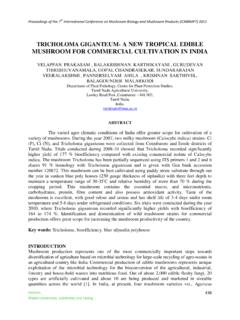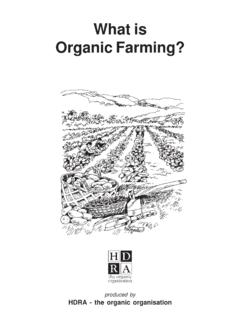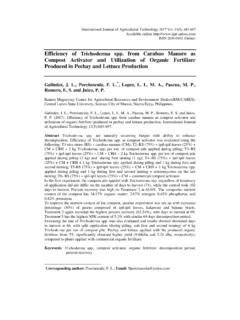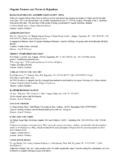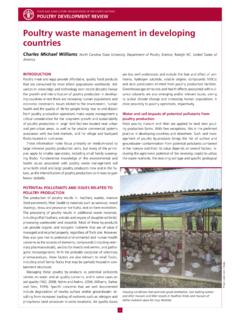Transcription of 'INDOOR' METHOD OF COMPOSTING AND GENETIC BREEDING OF THE ...
1 Proceedings of the 7th International Conference on Mushroom Biology and Mushroom Products (ICMBMP7) 2011 Section: Waste conversion, substrates and casing 419 "INDOOR" METHOD OF COMPOSTING AND GENETIC BREEDING OF THE STRAINS TO IMPROVE YIELD AND QUALITY OF THE ALMOND MUSHROOM AGARICUS SUBRUFESCENS. DIEGO C. ZIED *1; A. PARDO-GIMENEZ 2; SAVOIE 3; PARDO-GONZALEZ 4, P. CALLAC3 1M dulo de Cogumelo. Departamento de Produ o Vegetal, Universidade Estadual Paulista . Fazenda Lageado, PO box 237, CEP 18603-970, Botucatu, SP, Brazil.
2 2 Centro de Investigaci n, Experimentaci n y Servicios del Champi n (CIES), PO box 63, 16220 Quintanar del Rey, Cuenca, Spain 3 INRA, UR1264, Mycologie et S curit des Aliments, F-33883, Villenave d Ornon, France. 4 Escuela T cnica Superior de Ingenieros Agr nomos, Universidad de Castilla-La Mancha, Campus Universitario, s/n, 02071 Albacete, Spain ABSTRACT The aim of the present work was to evaluate the potential efficiency of an indoor COMPOSTING METHOD and the GENETIC BREEDING of strains on the agronomic performance (yield, number and weight of basidiocarps, precociousness and earliness) and quality of A.
3 Subrufescens mushrooms. The experiment followed a factorial combination (3 composts types x 4 strains) with five replicates per treatment. One strain was a hybrid between French and Brazilian isolates. Strains and composts affected all variables analyzed (yield, number of basidiocarps, precociousness and earliness), except the weight of basidiocarps harvested. According to agronomic performance, yield was positively correlated with the number of basidiocarps and precociousness but was negatively correlated with earliness.
4 According to chemical characteristics of basidiocarps, moisture was positively correlated with the amount of fat; protein was negatively correlated with the amount of hemicellulose and finally, hemicellulose was negatively correlated with the amount of cellulose present in the mushrooms. Despite the observed differences between composts, the best COMPOSTING process for the cultivation of A. subrufescens is still unknown, requiring further research with management approaches, methods and formulations to be used for the commercial production of a selective substrate.
5 The intercontinental hybrid possessed improved quality characteristics while yielding similar to its better parent. BREEDING programs for improving mushroom quality and yield of A. subrufescens would be warranted. Keywords: Agaricus subrufescens; compost; GENETIC BREEDING ; chemical characterization; agronomic performance. INTRODUCTION Since the first tests performed in 1980 by Takatoshi Furumoto, agronomist, production of Agaricus subrufescens (formerly A. blazei, A.)
6 Brasiliensis) was done on basis of cultivation practices adopted for the production of Agaricus bisporus. Even today, little has changed especially with Proceedings of the 7th International Conference on Mushroom Biology and Mushroom Products (ICMBMP7) 2011 Section: Waste conversion, substrates and casing 420 growing practices to improve yield (15-25%), earliness (70% of total yield in the first half of the crop), duration of flushes (4 days of harvest), interval between flushes (3-5 days) and crop cycle (50-60 days).
7 Strains used for the cultivation of A. subrufescens in Brazil are marketed as varieties collected indigenously, that were selected through domestication and adaptation to the cultivation conditions of the farms (type and formulation of the compost and local environmental conditions). The consequences are a great variability in yield, a long growing cycle and a lack of control over the specific growth characteristics of the strains. Agaricus subrufescens has been characterized as a tropical mushroom with fruiting temperatures used during cultivation usually between 25 and 29 C.
8 However mycologists have collected fruiting bodies in temperate countries such as Belgium and France [1; Guinberteau, pers. com.], showing the species has an extended geographic distribution. Because of this great geographic distribution, the important work of GENETIC BREEDING and acquisition of new hybrids can be performed, creating individuals with specific characteristics for production in different conditions worldwide. In Brazil, the traditional process of COMPOSTING has been widely practiced by growers, following the steps of: pre-wetting (4-7 days), fermentation (formation of the windrow 2 m wide x 2 m high, with intervals of turning every 2-3 days), pasteurization (58 2 C) and physical, chemical and biological conditioning (47 2 C) [2].
9 The raw materials commonly used as bulk compost are: sugar cane bagasse (Saccharum officinarum), various grasses (Braquiar a sp., Cynodon dalactylon, Panicum maximum, etc), cereal straw (Triticum aestivum, Avena sativa, Oryza sativa, etc.) and manure. Already as concentrated material (nitrogen source or not) soybean, wheat, corn and cotton meal, urea, ammonium sulfate, superphosphate, calcium carbonate and gypsum are used [3]. In 1986, the first METHOD of "indoor" COMPOSTING used for the production of A.
10 Bisporus was proposed [4], later called "environmental control" [5] and "accelerated" [6] COMPOSTING , in order to accelerate the COMPOSTING process to limit anaerobiosis and bad smells, to decrease the loss of material during the COMPOSTING process, to reduce the physical space of the operations, and the use of machines [7]; and especially to increase process efficiency and productivity. Productivity is a direct consequence of operating quality practiced during the COMPOSTING process, both with respect to the design of the theoretical formulation, as well as a civil structure existing and used [8].



